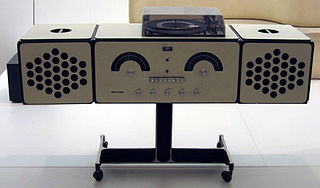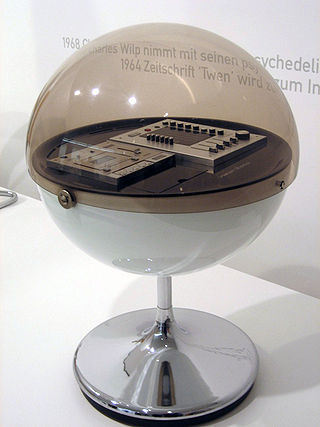
Music centre
Encyclopedia



Loudspeaker
A loudspeaker is an electroacoustic transducer that produces sound in response to an electrical audio signal input. Non-electrical loudspeakers were developed as accessories to telephone systems, but electronic amplification by vacuum tube made loudspeakers more generally useful...
s, though some equipment also has these built in to the main unit.
Integrated audio equipment has a long history, beginning with the integration of the record player and the wireless
Wireless
Wireless telecommunications is the transfer of information between two or more points that are not physically connected. Distances can be short, such as a few meters for television remote control, or as far as thousands or even millions of kilometers for deep-space radio communications...
receiver. Such units were usually called radiograms or stereograms. Very often these were designed as items of household furniture
Furniture
Furniture is the mass noun for the movable objects intended to support various human activities such as seating and sleeping in beds, to hold objects at a convenient height for work using horizontal surfaces above the ground, or to store things...
, with a large wooden cabinet on legs. These units were originally monaural
Monaural
Monaural or monophonic sound reproduction is single-channel. Typically there is only one microphone, one loudspeaker, or channels are fed from a common signal path...
, and featured a single integrated loudspeaker in the main body of the cabinet. By the 1960s these units had become smaller, and had developed to include stereophonic reproduction. The necessity of having suitable separation of the speakers meant that the single cabinet designs evolved into three-box designs, and the main box could become much smaller. By the beginning of the 1970s systems were starting to be made of plastic and other materials rather than wood.
The 1970s saw the inclusion of a deck for playing compact cassette
Compact Cassette
The Compact Cassette, often referred to as audio cassette, cassette tape, cassette, or simply tape, is a magnetic tape sound recording format. It was designed originally for dictation, but improvements in fidelity led the Compact Cassette to supplant the Stereo 8-track cartridge and reel-to-reel...
s as well as a record player and receiver, and the term music centre came into common use. The inclusion of a turntable capable of playing full-sized gramophone record
Gramophone record
A gramophone record, commonly known as a phonograph record , vinyl record , or colloquially, a record, is an analog sound storage medium consisting of a flat disc with an inscribed, modulated spiral groove...
s tended to dictate the overall size of these units, which remained relatively large. The cassette component was either a top-loading unit beside the turntable or a front-loading unit mounted on a deeper front panel. By the end of the decade, the first very small systems started to appear, which dropped the integrated record player in order to reduce the size of the other components significantly. Other innovations such as electronic control of the cassette transport mechanism (as opposed to direct mechanical operation) allowed further size reductions.
The compact disc
Compact Disc
The Compact Disc is an optical disc used to store digital data. It was originally developed to store and playback sound recordings exclusively, but later expanded to encompass data storage , write-once audio and data storage , rewritable media , Video Compact Discs , Super Video Compact Discs ,...
appeared in the early 1980s and the integrated hi-fi system came into its own, because the small size of a CD player compared to a turntable meant that this function could be reintegrated into the main unit without compromising its small size. The cassette remained a standard part of these systems until the late 1990s, where it was gradually eliminated in favour of other technologies such as the Minidisc
MiniDisc
The disc is permanently housed in a cartridge with a sliding door, similar to the casing of a 3.5" floppy disk. This shutter is opened automatically by a mechanism upon insertion. The audio discs can either be recordable or premastered. Recordable MiniDiscs use a magneto-optical system to record...
.
The music centre has always been rather looked down upon by the hi-fi enthusiast. In the early days the sound quality was far below what was possible using separate components. The main compromise is in the area of the loudspeakers, where small size is favoured over the ability to reproduce an extended low frequency response. Modern equipment has improved in this respect, and such systems are popular. There are still some compromises in terms of what components are used within the integrated unit, compared to what could be fitted in a set of separates, but the differences are smaller than they used to be.
The market for these systems is probably now larger than that for "true" hi-fi. Small units take up less space, and are more suitable in urban areas.

